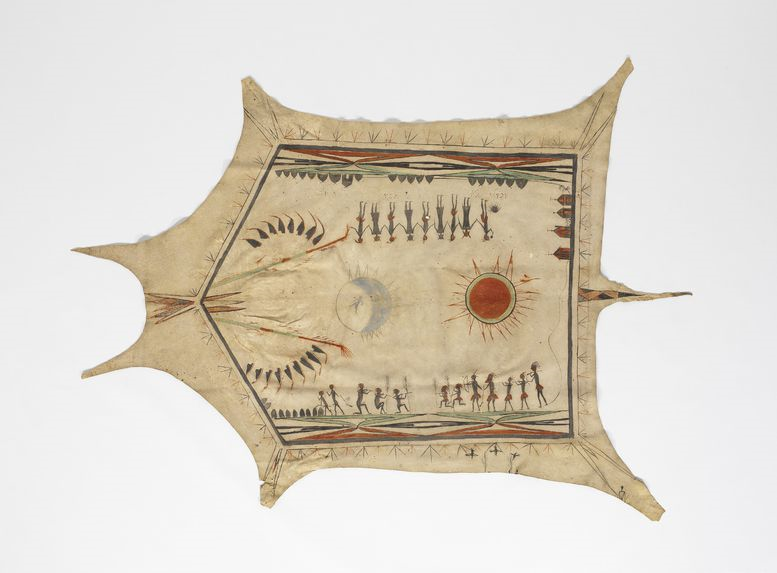Background
In the eighteenth century, the area of land known today as Arkansas was inhabited by the clans of the Quapaw people. This same land was also claimed by the French as part of their colony of Louisiana. Like the French, the Quapaw were fairly recent arrivals to the area, and they welcomed the opportunity to make an alliance with a partner who could provide superior weaponry to protect them from rival Native tribes. The French and Quapaw established a mutually beneficial relationship, but the Quapaw always maintained their sovereignty and cultural practices.
Quapaw clans were patriarchal, meaning that clan membership was tied to the father, not the mother. Even so, Quapaw women wielded far more influence in their communities than European women. Quapaw women produced all of the food that kept their communities fed, which entitled them to a place in community councils and an active role in the diplomacy with foreign powers. Some Quapaw women rose to the status of chief in their communities.
The Quapaw were pushed out of their lands in the Arkansas valley by the United States government in 1834. Today the Quapaw nation is based in northeastern Oklahoma.
About the Artifacts
This painted buffalo hide, considered a masterpiece of Native art, was made by Quapaw women. They both tanned and stretched the skin, and painted the beautiful images. Quapaw painted hides were renowned throughout the Louisiana colony. The Quapaw used the painted hides to decorate their homes.
The hide measures 7½ x 5½ feet, and has a lot of fascinating details. The three Quapaw villages—Osotuoy, Tourima, and Kappa—are depicted along the top edge. The right edge depicts a French fort, which historians have identified as Arkansas Post. On the bottom edge, is a drawing of Quapaw defeating another Native tribe in battle (given the time period, it is probably the Chickasaw). And above the Quapaw villages, on the top edge, is a drawing of a Quapaw dance or ceremony with both men and women participating. In the center, is a sun and moon, along with decorative calumets forming a V shape on the left.
Vocabulary
- calumet: A ceremonial pipe.
- Chickasaw: The Native tribe that originally inhabited territory that stretched across modern-day Mississippi, Alabama, Tennessee, and Kentucky. Today, the Chickasaw nation is headquartered in Oklahoma.
- hide: Animal skin.
- Louisiana: Founded in 1682, this colony was the second North American colony claimed by the French. The territory stretched from the Great Lakes to the Gulf of Mexico, between the Appalachian and Rocky Mountains.
- Quapaw: The Native tribe that inhabited the territory known today as Arkansas in the early eighteenth century. Today the Quapaw Nation is headquartered in Oklahoma.
- sovereignty: Self-government.
- tan: The process of turning animal skin into leather.
Pronunciation
- calumet: KHAL-you-meh
- Quapaw: KWAA-paw
Discussion Questions
- What do the images on this painted hide reveal about the world the Quapaw inhabited when it was made?
- Why did the artists include the French fort?
- How was an object like this made? What role did women play in the creation of painted hides?
Suggested Activities
- Include this object in lessons about Quapaw community, history, and culture.
- Assign students different sections of the robe to analyze and interpret, and then put together a class narrative of the story the robe is telling.
- The Quapaw women who helped make this robe were only some of the many women making art in the American colonies. Combine this object with the resources below for a lesson about colonial women artists: Mourning Poetry of Anne Bradstreet, A Nun Challenges the Patriarchy, Life Story: Maria Sybilla Merian, Revolution in Art, and Henrietta Johnston.
- Native people across North and South America had a variety of responses to the arrival of European colonizers. Combine this painted robe with any of the resources below for a larger consideration of ways Native communities responded to colonization: Life Story: Weetamoo, Life Story: Malitzen (La Malinche), Life Story: The Gateras of Quito, Life Story: Kateri Tekakwitha, Life Story: Quashawam, Revolution in Art, Life Story: Marguerite Faffart, Life Story: Toypurina, Selling Staten Island, Frontier Diplomacy, Life in the Mission System, Life Story: Tituba, and Life Story: Mother Esther Marie-Joseph Wheelwright de l’Enfant.
- Have students consider how Quapaw women used works of art like this object to tell a story and then create their own wearable or decorative piece that tells a story about student communities in this arts integration activity.
Themes
AMERICAN CULTURE; POWER AND POLITICS
New-York Historical Society Curriculum Library Connections
- For more resources relating to New Netherland and New York colonies, see New World—New Netherland—New York.







